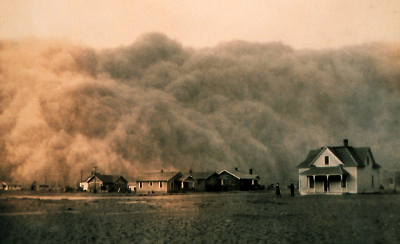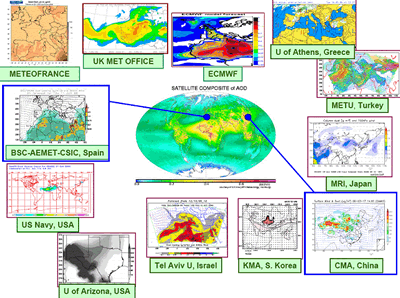SDS about
WMO Sand and Dust Storm Warning Advisory
and Assessment System
(SDS-WAS)
Introduction
Aerosols such as mineral dust are particles suspended in air. The size of aerosols in general
ranges from a few nanometers up to some hundred micrometers.
The mineral aerosol has it sources in sand and dust storms, which are the main origins of the natural atmospheric aerosol. When winds are strong and other (near-) surface atmospheric conditions (such as turbulence level, stability, soil moisture) are favorable, large amounts of sand and dust can be lifted from bare, dry soils into the atmosphere. Every year about 1.5 Giga tons (Gt) of sand and dust are emitted from deserts into the atmosphere (the flux is estimated to be between 1.0 and 2.15 Gt per year).

Dust storm in Texas; Wikimedia Commons
Suspended sand and dust generates semi-permanent patterns of local and regional scales that persist in the atmosphere for several days. Moreover dust can be transported downwind affecting regions hundreds to thousands of kilometers away. The distance of transport is mainly depending on the meteorological conditions in the free atmosphere.
Although it is not usually considered, dust plays an important role in our everyday life affecting e.g. human and veterinary health (asthma, infections, Meningitis in Africa, Valley fever in America). Furthermore dust aerosols have numerous impacts on environment, agriculture, marine ecosystems (productivity), fisheries, transport in dusty regions, visibility, aviation (air disasters) and weather and climate at larger scales. Once in the atmosphere the particles interact with solar and thermal radiation and clouds, having an impact on the Earth radiation balance and thus influencing the Earth’s weather and climate.
Scientific Background
Today, there is accumulated scientific evidence on different roles of dust on environment and climate. The schematic diagram below shows the atmospheric dust process and the impacts of atmospheric dust.
By clicking on an element in the diagram (or on a tag from the following list: anthropogenic impact, dust sources and dust process, health aspects, impact on biosphere, impact on climate and weather, impact on hurricanes, impact on ocean, measurement techniques, transport), a review and a list of corresponding publications will appear allowing a more detailed study of different aspects. Below the diagram there is a link to the whole publication list for all the considered issues.

Atmospheric dust process and impacts;
Publication list sand and dust occurence
Modeling of sand and dust storm events
Modeling of dust transport and concentrations in the atmosphere is very important to contribute to risk reduction in many areas (aviation, health impacts, etc.). During the last decade, a dozen numerical modeling systems for sand and dust forecasting have been developed. Most models are using atmospheric weather prediction models as an on-line driver. Dust particle distribution is introduced in the models as a common component. The dust mass conservation equation is embedded as one of the model governing equations. To simulate the sand and dust storm processes advanced numerical parameterization methods are used.
The previous-day predicted/simulated concentration field has to be used as an initial one for a proceeding day, because of the lack of 3D observations of mineral dust. In general there are limited dust-concentration data available, which makes model validation difficult. Another problem is the resolution in the atmospheric models- it is typically 10 to 100 km, which is too coarse to represent the spatial variations of dust emission.
The SDS-WAS programme contains of many research and/or operational institutes performing daily forecasts of sand and dust (see diagram below).

Overview of SDS-WAS models; the blue spots show the two regional nodes;


